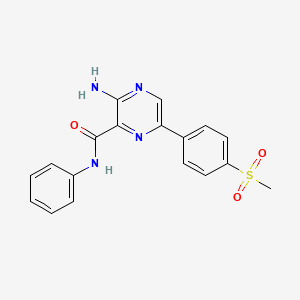Drug Information
Drug (ID: DG01590) and It's Reported Resistant Information
| Name |
VE-821
|
||||
|---|---|---|---|---|---|
| Synonyms |
VE-821; 1232410-49-9; 3-Amino-6-(4-(methylsulfonyl)phenyl)-N-phenylpyrazine-2-carboxamide; VE 821; VE821; 3-Amino-6-[4-(methylsulfonyl)phenyl]-N-phenyl-2-pyrazinecarboxamide; UNII-BF884TQ935; CHEMBL1766779; 3-amino-6-(4-methylsulfonylphenyl)-N-phenylpyrazine-2-carboxamide; BF884TQ935; 3-AMINO-6-(4-METHANESULFONYLPHENYL)-N-PHENYLPYRAZINE-2-CARBOXAMIDE; 3-Amino-6-(4-(methylsulfonyl)phenyl)-N-phenyl-2-pyrazinecarboxamide; 2-Pyrazinecarboxamide, 3-amino-6-(4-(methylsulfonyl)phenyl)-N-phenyl-; 2-Pyrazinecarboxamide, 3-amino-6-[4-(methylsulfonyl)phenyl]-N-phenyl-; ATR Inhibitor IV; MLS006011215; GTPL8042; SCHEMBL2483543; DTXSID60679574; EX-A530; CHEBI:124916; HMS3653B19; HMS3673C07; HMS3744G05; BCP02617; 2788AH; BDBM50341733; MFCD19443686; NSC761070; s8007; ZINC68244543; AKOS025212610; CCG-268268; CS-0238; NSC-761070; SB19277; NCGC00346444-01; NCGC00346444-07; AC-30933; AS-72494; BV168070; HY-14731; SMR004702977; VE-821, >=98% (HPLC); FT-0700135; SW219507-1; J-690084; Q27089128; 3-Amino-6-[4-(methlsulfonyl)phenyl)-N-phenyl-2-pyrazinecarboxamide; 3-Azanyl-6-(4-methylsulfonylphenyl)-N-phenyl-pyrazine-2-carboxamide; 3-amino-6-(4-(methyl sulfonyl)phenyl)-n-phenyl-2-pyrazinecarboxamide; 3-Amino-6-[4-(methanesulfonyl)phenyl]-N-phenylpyrazine-2-carboxamide
Click to Show/Hide
|
||||
| Indication |
In total 1 Indication(s)
|
||||
| Structure |

|
||||
| Target | Serine/threonine-protein kinase ATR (FRP1) | ATR_HUMAN | [1] | ||
| Click to Show/Hide the Molecular Information and External Link(s) of This Drug | |||||
| Formula |
4
|
||||
| IsoSMILES |
CS(=O)(=O)C1=CC=C(C=C1)C2=CN=C(C(=N2)C(=O)NC3=CC=CC=C3)N
|
||||
| InChI |
InChI=1S/C18H16N4O3S/c1-26(24,25)14-9-7-12(8-10-14)15-11-20-17(19)16(22-15)18(23)21-13-5-3-2-4-6-13/h2-11H,1H3,(H2,19,20)(H,21,23)
|
||||
| InChIKey |
DUIHHZKTCSNTGM-UHFFFAOYSA-N
|
||||
| PubChem CID | |||||
| ChEBI ID | |||||
Type(s) of Resistant Mechanism of This Drug
Drug Resistance Data Categorized by Their Corresponding Diseases
ICD-02: Benign/in-situ/malignant neoplasm
| Drug Sensitivity Data Categorized by Their Corresponding Mechanisms | ||||
|
|
||||
| Key Molecule: AT-rich interactive domain-containing protein 1A (ARID1A) | [1] | |||
| Molecule Alteration | Nonsense | p.Q456* (c.1366C>T) |
||
| Sensitive Disease | Colorectal cancer [ICD-11: 2B91.1] | |||
| Experimental Note | Revealed Based on the Cell Line Data | |||
| In Vitro Model | ES2 cells | Ovary | Homo sapiens (Human) | CVCL_AX39 |
| TOV21G cells | Ovary | Homo sapiens (Human) | CVCL_3613 | |
| SMOV2 cells | Ovary | Homo sapiens (Human) | CVCL_S920 | |
| RMG-1 cells | Ascites | Homo sapiens (Human) | CVCL_1662 | |
| OVTOKO cells | Spleen | Homo sapiens (Human) | CVCL_3117 | |
| OVSAYO cells | Ovary | Homo sapiens (Human) | CVCL_3115 | |
| OVMANA cells | Ovary | Homo sapiens (Human) | CVCL_3111 | |
| OVISE cells | Pelvi | Homo sapiens (Human) | CVCL_3116 | |
| OVAS cells | Ascites | Homo sapiens (Human) | CVCL_0V12 | |
| KOC7C cells | Pleural effusion | Homo sapiens (Human) | CVCL_5307 | |
| KK cells | Ascites | Homo sapiens (Human) | CVCL_F844 | |
| HCH1 cells | Ovary | Homo sapiens (Human) | CVCL_DF05 | |
| In Vivo Model | CD-1 Nude mouse PDX model | Mus musculus | ||
| Experiment for Molecule Alteration |
Western blotting analysis | |||
| Experiment for Drug Resistance |
ApoTox-Glo triplex assay | |||
| Mechanism Description | Defects in ARID1A sensitize tumour cells to clinical inhibitors of the DNA damage checkpoint kinase, ATR, both in vitro and in vivo. Mechanistically, ARID1A deficiency results in topoisomerase 2A and cell cycle defects, which cause an increased reliance on ATR checkpoint activity. In ARID1A mutant tumour cells, inhibition of ATR triggers premature mitotic entry, genomic instability and apoptosis. | |||
References
If you find any error in data or bug in web service, please kindly report it to Dr. Sun and Dr. Zhang.
